Lock On: Modern Air Combat Q&A
We sit down with Ubi Soft's Matt Wagner to discuss this intriguing flight combat game.
Movies like Top Gun and outstanding games like IL-2 Sturmovik and Flanker 2.5 have helped capture the exhilaration and challenge of taking to the skies in a fighter plane and fighting exciting aerial battles. Games like these are experiencing something of a renaissance, and even though it's been popular in the past to set combat flight sims in historical conflicts, like World War II, we're glad to see a new crop of games that take place in modern-day settings, complete with the kind of the sleek, top-of-the-line multimillion-dollar fighter jets and attack choppers we've already enjoyed seeing in action in films like Behind Enemy Lines and Black Hawk Down.
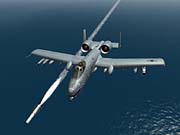
One of the most promising games in this new breed of flight sims is Lock On: Modern Air Combat, a game set in a modern-day, fictitious conflict. Lock On will let you fly nine of the world's top military aircraft, including the F-15C Eagle, the A-10A Thunderbolt, and the Su-33 Flanker, and engage in fierce, fast-paced dogfights with enemy pilots. From what we've seen of the game so far, Lock On promises some very impressive-looking graphics, including beautiful environments and incredibly detailed ships--which are carefully modeled down to the individual dials and switches in the cockpit. And much like in the most exciting movies (and with the real thing), you'll have your hands full with chatter from both your allied wingmen, as well as from friendly AWACS (airborne warning and control system) aircraft and ATC (air traffic control) on the ground. And though the developer plans to have a campaign game in place, Lock On will also have instant-action modes that will let you hop into the cockpit and get right to the point.
To find out more about this promising game, we checked in with Matt Wagner, former intelligence analyst for the US government, designer of Jane's F/A-18, and producer of Lock On: Modern Air Combat at Ubi Soft.
GameSpot: Thanks for taking the time for this interview. It seems that the combat flight simulators we've seen in the past few years were mainly focused on historical conflicts, especially World War II. Could you explain why you chose to go with a modern-day setting for Lock On instead?
Matt Wagner: Lock On began as an outgrowth of Flanker 2.5 by Eagle Dynamics. Three of the flyable aircraft from this title were the Su-27 Flanker B, the Su-33 Flanker D, and the MiG-29K Fulcrum. Given the work already accomplished for these aircraft, it was a logical choice to bring the Su-27 and Su-33 over to Lock On. Initially, what is now called Lock On was once termed Flanker Attack. This product was to add a dedicated Russian ground attack aircraft in the form of the Su-39 Frogfoot (also known as the Su-25T). Like the Flanker 2.5 aircraft, the Su-39 was also included in Lock On. With the demise of other A-10A simulations and the strong desire in the flight simulation community to fly the Hog, we felt it was a great opportunity to take advantage of. This combined with adding a true counterpart to the Su-39 led to our decision to add the A-10A. To round out the mix of US and Russian aircraft and to provide a counterpart to the Su-27 we decided to add the air superiority, "not a pound for air-to-ground," F-15C Eagle, instead of the F-15E variant. Finally, we added the ground-based versions of the Fulcrum--the German MiG-29 Fulcrum A and the Russian MiG-29 Fulcrum C--as well as the Su-25 Frogfoot.
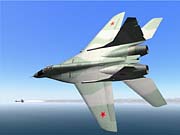
There is only one other major "modern" air combat simulation in development at the moment besides LO: MAC. That competitive title is historical in nature and does not feature current, modern-day aircraft. There is room for competition in the area of combat flight simulations, but we certainly like the opportunity of being one of the only ones in development. Overall, the differences between LO:MAC and the other moderns sims that were released in the past few years are the following:
We are taking the best elements of a study simulation, which focuses on detail and high fidelity on one particular aircraft, and combining it with the variety of a survey simulation, featuring a wider range of flyable aircraft that are modeled in detail with respect to performance and appearance.
We are focusing on both Russian and Western aircraft.
And we are attempting to create a product that appeals to both the sophisticated or "veteran" flight sim users while making the game accessible to the new or novice player.
Going Ballistic
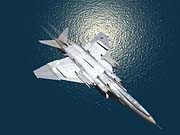
GS: We've already heard about (and seen) Lock On's impressive 3D cockpit, which realistically models every last switch and gauge in each of the game's ships. Could you discuss what other measures you're taking to make sure Lock On delivers a realistic experience?
MW: In terms of artificial intelligence (AI): Much like other areas of Lock On, the AI can be highly scalable. For novice players, it can be like shooting fish in a barrel, or at the high settings, most players will have their hands full.
When at the higher settings, Lock On's AI pilots will be much smarter about energy management of the jet, better about avoiding incoming missiles, better about flight profiles during air and ground attacks, and they can be deadly dogfighters. Along with these autonomous functions, the AI will now react to a wide variety of radio commands that can be issued by the player. These range from having wingmen attack certain types of targets, AWACS providing vector information, or ATC giving smart and logical flight data.
In terms of communications: An important lesson learned from the Flanker series of games was to increase the level of interaction with wingmen and AWACS. In Lock On, this is accomplished through a tiered radio message system that enables the player to have fine control of his or her wingmen. The player can easily control individual wingmen or the entire flight through the tiered system or a set of hotkeys. Some of the orders that the player can issue include separate commands for engaging a wide array of target types, the ability to have wingmen carry out preassigned missions without further assistance from the player, multiple formation types and variations of them, vectoring wingmen to various locations, control activation of sensors and countermeasure systems, as well as intercept tactics.
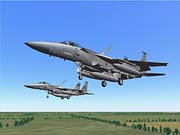
In terms of avionics: A great deal of time and effort has been spent on the avionics of the F-15C and A-10A. Using unclassified manuals for both of these aircraft that detail the various avionics systems, Eagle Dynamics has created very accurate replications of these aircraft. Although every single submode and widget may not be included, virtually all the primary functions associated with these aircraft have. This ranges from radar, to heads-up displays (HUD), to radar warning receivers (RWR). A real Eagle or Warthog pilot will feel right at home in Lock On.
True to their real-life counterparts, most Russian aircraft use very similar avionics suites in regards to HUDs and RWRs. Because the avionics for the Su-27 were fairly accurate in Flanker 2.5, this avionics suite has been carried over to Lock On for all Russian aircraft. If time permits, we may do some special modeling of the Su-27 and Su-25 systems.
GS: On the other hand, too much realism and complexity in flight sims can make them intimidating for new players. What kinds of measures will you be taking to make sure new players will be able to get up and running?
MW: We have made scalability a big part of the simulation. The user has a choice of using the realistic or easy modes for radars, flight modeling, and survivability aspects of the simulation. By providing users with flyable aircraft from both Western and Eastern orders of battle, we are providing something for people in both the domestic and global markets to enjoy. We hope that this product appeals to a wider audience than the Flanker series of products that only featured Russian aircraft as flyable to the user.
We had a very good base to work from with the Flanker series, but we realized we needed to add Western aircraft to the mix to make the game appeal to a wider market by making it easier to get started and making the gaming elements of the simulation an important part of the experience.
You Are Cleared for Takeoff
GS: We know that in addition to Lock On's single-player campaign, the game will also have an instant-action mode. Could you discuss how instant action will work in Lock On?
MW: Lock On will feature two modules that will enable players to enter the action with a minimum of planning and fuss:
The first is the fast battle planner. For those that do not care to venture into the editor, the fast battle planner allows players to create many types of missions by the selection of a dozen or so criteria. From there, the FBP will automatically generate the mission, and the player is off and flying.
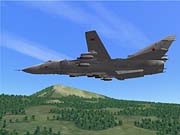
The second is quick start. If a player simply wants to select an aircraft and immediately start blowing things up, the quick start is for them. The player simply selects the fly button next to a picture of each flyable aircraft, and the mission begins.
GS: Could you discuss Lock On's campaign? Where will it take place, and what sort of missions will be in it? Will Lock On have a dynamic campaign that branches out into different missions as you play?
MW: Lock On's campaign system is still under development, and its actual content is still greatly in flux. Until the campaign has been solidified and working as planned, it would be premature to address this question at this time.
GS: Could you discuss your plans for Lock On's multiplayer play? What kind of multiplayer modes will be available?
MW: Lock On introduces a new multiplayer interface from the Flanker series that enables players to join prearranged flights or add their own flight to the mission. The interface has been greatly streamlined and allows players to quickly scan for sorties, determine the participants, and join the mission. We envision at least 32 players to be able to play online (depending on bandwidth), but this of course can be a function of Internet latency.
The Lock On multiplayer module will allow both head-to-head and cooperative gameplay. Upon joining a game, players will have the opportunity to select a flight, or they can even create their own. It will be quite possible to have one side fly Russian aircraft and the other American. Furthermore, missions can be created in which players fly different types of aircraft. For example, Side A players could be flying a combination of F-15Cs and A-10s, while Side B is flying Su-27s and Su-39s.
GS: Are there any plans to open up Lock On for independent modification (mods)? Will fans be able to create their own planes or scenarios? Any plans for in-game editing tools?
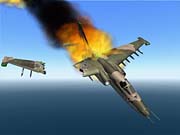
MW: We are currently investigating the inclusion of a skin loader. We understand that there are many people that enjoy modifying the look of the game, and as with Flanker 2.5, most of our art resources are open. The mission editor is going to provide the community with the ability to create missions that can be made available for others to fly.
GS: To what degree will damage affect an airplane's performance in the game, and how will damage be represented visually on the planes' 3D model?
MW: In fact, we have released several screenshots of Lock On's damage modeling, on the www.lo-mac.com Web site. In regards to how damage affects aircraft performance, the development team, Eagle Dynamics, is still determining the specifics of that.
Into the Wild Blue Yonder
GS: There doesn't seem to be much in the way of naval aviation in Lock On. Why is that? Would a sea-based expansion pack be a possibility if Lock On becomes a commercial hit?

MW: There is some naval aviation in Lock On, in the form of the Su-33 Flanker D. Using the Su-33, players can conduct operations from the Russian aircraft carrier Kuznetsov. Additionally, there is a broad range of other Russian and US vessels that can move, follow waypoints, and engage naval and air targets. The complete list of vessels is on the official FAQ at the LO:MAC Web site.
However, Lock On is focused on ground-based air operations, not naval. This is primarily due to the fact that large-scale naval operations would never take place in the Black Sea. If Lock On is a retail success, anything is possible in regards to expansion. For now, though, our focus is on completing Lock On.
GS: What's your favorite plane in Lock On so far, and why?
MW: It actually depends on the mission--there are specific aircraft that work better in certain situations than others, but part of the fun with a game like this is that you can fly a number of different planes and find your own favorite for every situation.
GS: Finally, is there anything else you'd like to add about Lock On?
MW: Ah, the "catch all" question. We have made LO:MAC with the future in mind. We have many plans for this product line in the form of follow-on products and sequels. We would like very much to see this simulation feature another global region like the Western Pacific, where contemporary geopolitical tensions provide us with the opportunity to create interesting missions. Moving to a region like the Pacific also provides us with the opportunity to expand the scope of the product line to include naval operations while providing more military units and aircraft to feature.
We'd like to see this product line be the basis of the much-desired "digital battlefield" concept where modules covering other aircraft and military units tie in together. It's something many of us have wanted to see for the past 10 years.
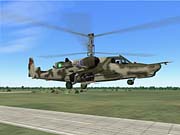
The possibility of combining third-person-perspective strategy games with first-person-perspective simulations would add command and control elements to the gameplay. The dream of many in the simulation community has been to combine air, naval, and ground forces into a product that allows major battles to be fought between players at various levels of command. This is a very exciting area that we would like to explore.
We'd also like to add more flyable aircraft to the LO:MAC product line. There is much demand among the online simulation community for a variety of aircraft that have not been the focus of previous simulation products. There are many European and Western aircraft that people tell us they want to fly in LO:MAC. We are also interested in looking into the possibility of next-generation aircraft such as the Su-37 Super Flanker, the F-22 Raptor, or the F-35 Joint Strike Fighter.
All of these exciting ideas are possible, provided the initial LO:MAC product is successful. Combat simulations are very difficult to develop and publish. Because of the detailed and complex nature of these products, the average gamer is difficult to recruit into the ranks of the sim community. It takes time and effort to be good at this type of game. This means the market for a combat simulation product is smaller than that of first-person shooters or arcade racing games. If simulations are to thrive, we as publishers and developers have to provide compelling and fun products that will appeal to a wider range of consumers than combat simulations have attracted in the past. It's an uphill battle, but we are confident we have a fine product in LO:MAC. Thanks very much!
But please note: As with any project in development, we want to stress that sometimes we are forced to make changes to features, so please understand that everything we've stated here is subject to change.
GS: Thanks, Matt.
Got a news tip or want to contact us directly? Email news@gamespot.com
Join the conversation